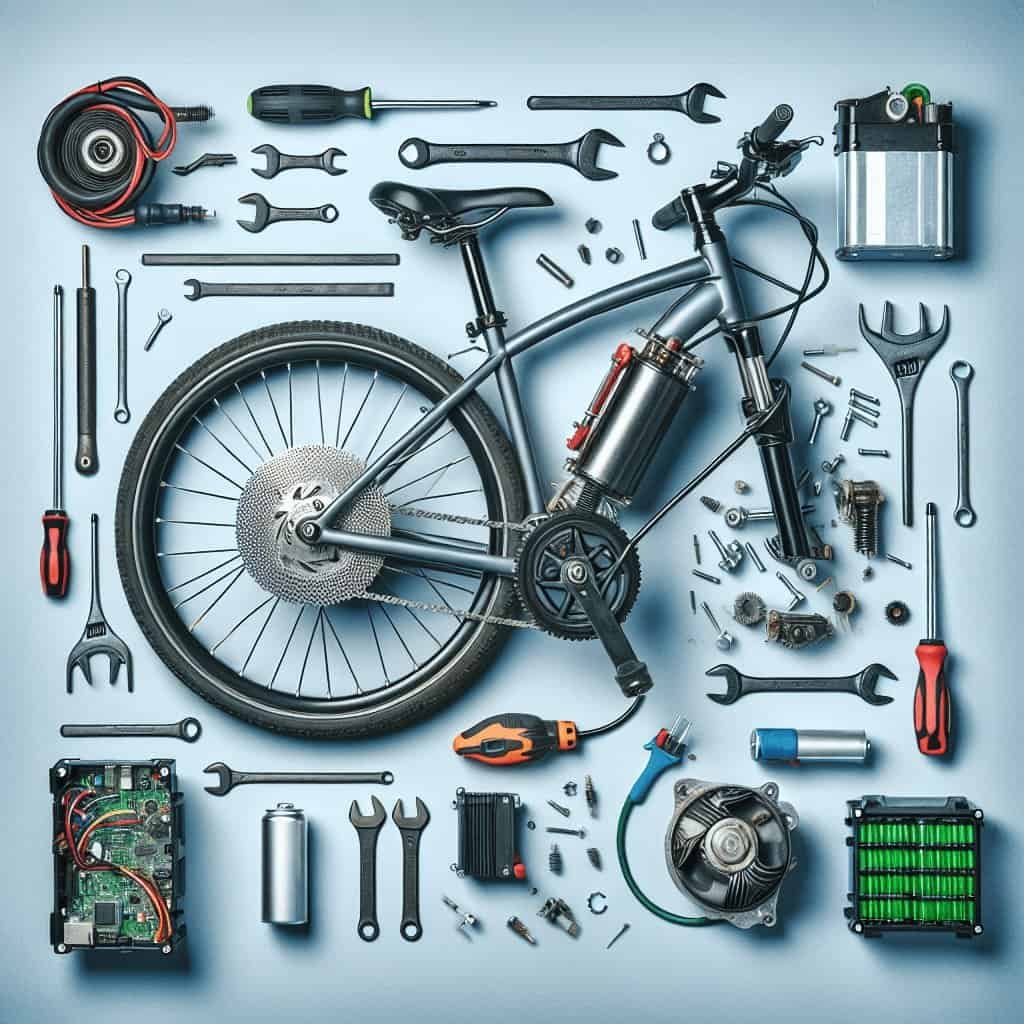Have you ever wondered if it’s possible to transform your traditional bike into an electric one? The answer is yes! Retrofitting your regular bike to make it electric has become a popular trend among cyclists. By adding a conversion kit, you can conveniently upgrade your bike’s power and enjoy the benefits of an electric ride without having to invest in an entirely new e-bike. In this article, we will explore the process of retrofitting, the advantages it offers, and the various options available to turn your beloved bicycle into a powerful electric machine. So, if you’re intrigued by the idea of zipping effortlessly through your daily commute or conquering challenging terrains with ease, let’s delve into the world of retrofitting and discover the possibilities awaiting you.
Benefits of Electric Bikes
Improved efficiency and speed
One of the main benefits of electric bikes is their improved efficiency and speed. With the assistance of the electric motor, you can easily reach higher speeds and cover longer distances with less effort compared to traditional bikes. The motor provides an extra boost, allowing you to ride at a faster pace and arrive at your destination more quickly.
Reduced effort and fatigue
Electric bikes are designed to reduce the physical effort required when cycling, making it a more enjoyable experience for riders of all fitness levels. The electric motor provides assistance when pedaling, making it easier to tackle challenging terrains or longer distances. This reduction in effort can also be beneficial for older individuals or those recovering from injuries, making cycling more accessible to a wider range of people.
Environmentally friendly
As awareness about environmental issues continues to grow, electric bikes offer a more sustainable transportation option. By choosing to ride an electric bike instead of driving a car, you are helping to reduce carbon emissions and decrease your carbon footprint. Electric bikes have lower energy consumption compared to cars, making them a greener alternative for short-distance commuting or running errands.
Cost-effective transportation
Compared to other forms of transportation, electric bikes can be a cost-effective option in the long run. While the initial cost of purchasing an electric bike or retrofitting a regular bike with an electric conversion kit may seem expensive, it is a one-time investment that can save you money in the future. You can significantly reduce transportation costs by using your electric bike for daily commuting instead of relying on cars or public transport.
Enhanced fitness and health benefits
Contrary to the belief that electric bikes make you lazy, they can actually provide health benefits. With adjustable levels of assistance, you have the freedom to choose the amount of effort you want to exert while cycling. Electric bikes still require pedaling, providing an excellent form of low-impact exercise that can improve cardiovascular fitness, muscle strength, and overall well-being. Electric bikes can also encourage individuals who may not have previously considered cycling as a form of exercise to engage in physical activity.
Factors to Consider Before Retrofitting
Legal regulations and restrictions
Before retrofitting your regular bike with an electric conversion kit, it is important to check your local regulations and restrictions regarding the use of electric bikes. Different countries and regions may have specific laws governing the use of electric bikes, including speed limits, maximum motor power, and age restrictions. Ensure you comply with these regulations to avoid any legal issues while riding your retrofitted electric bike.
Budget and cost considerations
Retrofitting your regular bike with an electric conversion kit can be a significant investment. Consider your budget and evaluate the cost of the conversion kit along with any additional accessories or components required. It is essential to choose a conversion kit that balances affordability with quality to ensure a reliable and long-lasting electric bike.
Type of bike and frame compatibility
Not all bikes are compatible with electric conversion kits. Assess the compatibility of your bike frame with various conversion kit options. Consider factors such as frame type, wheel size, and space availability to determine the best conversion kit for your bike. Additionally, some bike frames may require modifications or adapters to properly fit the conversion kit.
Battery size and weight
The battery is a crucial component of an electric bike, as it provides power to the motor. Consider the size and weight of the battery when choosing a conversion kit. A larger battery capacity will typically allow for a longer range, but it may also add weight to your bike. Evaluate your needs based on the distance you plan to travel and the expected battery life.
Motor power and performance
The motor is responsible for providing assistance while you pedal. Different electric conversion kits offer varying motor power and performance levels. Consider factors such as torque, maximum speed, and throttle options when selecting a motor. Choose a motor that aligns with your intended use, whether it be for leisurely rides or more challenging terrains.
Range and charging options
The range refers to the distance an electric bike can travel on a single battery charge. Consider your typical riding distances and choose a conversion kit that offers a range suitable for your needs. Additionally, evaluate the charging options available for the battery. Some conversion kits may include fast charging options or the ability to charge the battery on or off the bike.

Choosing an Electric Bike Conversion Kit
Front-wheel conversion kit
A front-wheel conversion kit involves replacing the front wheel of your regular bike with an electric motorized wheel. This type of conversion kit is relatively easy to install and provides a balanced weight distribution. However, it may affect the handling and traction of the bike, especially on slippery surfaces.
Rear-wheel conversion kit
Similar to a front-wheel conversion kit, a rear-wheel conversion kit replaces the rear wheel of your regular bike with an electric motorized wheel. This type of conversion kit offers better traction and handling compared to a front-wheel kit. However, it can add additional weight to the rear of the bike, potentially affecting the bike’s balance.
Mid-drive conversion kit
A mid-drive conversion kit involves replacing the bike’s existing crankset and bottom bracket with a motor and drive system. This type of conversion kit offers better weight distribution and a more natural riding experience. It allows the motor to utilize the bike’s gearing system, providing better torque and climbing abilities. However, mid-drive conversion kits can be more complex to install and may require professional assistance.
Features to consider
When choosing an electric bike conversion kit, consider additional features that may enhance your riding experience. Look for options such as regenerative braking, which helps recharge the battery while braking, or integrated lighting systems for enhanced visibility. Evaluate the quality and reliability of the components included in the conversion kit to ensure a hassle-free riding experience.
Motor power and torque
The motor power determines the level of assistance provided by the electric bike. Consider your intended use and the terrain you plan to ride on when selecting the motor power. Higher-powered motors offer more assistance and are suitable for challenging terrains or riders who require extra support. Additionally, evaluate the motor’s torque, as it affects the bike’s climbing abilities and acceleration.
Battery capacity and voltage
The battery capacity determines the range of the electric bike. Consider your typical riding distances and choose a battery with sufficient capacity to meet your needs. Additionally, evaluate the voltage of the battery, as it affects the motor’s performance. Higher voltage batteries typically provide more power and better performance.
Installation difficulty
Different electric conversion kits vary in terms of installation difficulty. Consider your technical skills and assess the level of complexity associated with each conversion kit option. Some conversion kits may require professional assistance or specialized tools for installation. Ensure you fully understand the installation process before purchasing a conversion kit.
Additional accessories and components
Take into account any additional accessories or components that may be included in the conversion kit. Some kits may come with features such as LCD displays for monitoring battery life and speed, as well as additional wiring harnesses, sensors, or controllers. Evaluate the value and usefulness of these accessories in relation to your specific requirements.
Steps to Retrofit Your Bike
Gather the necessary tools and equipment
Before starting the retrofitting process, ensure you have all the necessary tools and equipment. This may include wrenches, screwdrivers, cable ties, electrical tape, and any specialized tools recommended by the conversion kit manufacturer. Refer to the conversion kit instructions for a comprehensive list of required tools.
Select and purchase an electric bike conversion kit
Research and choose an electric bike conversion kit that best suits your needs based on the factors discussed earlier. Purchase the conversion kit from a reputable manufacturer or retailer. Ensure the kit includes all the necessary components for the retrofitting process.
Prepare your bike for conversion
Thoroughly clean your bike and remove any accessories or components that may interfere with the installation of the conversion kit. Assess the compatibility of your bike frame with the chosen conversion kit and make any necessary modifications or adjustments.
Install the electric bike conversion kit
Follow the detailed instructions provided by the conversion kit manufacturer to install the components. Pay close attention to the order of installation and ensure a secure and precise fit. Take your time during this process to prevent any potential damage or errors.
Connect the wiring and test the components
Carefully connect the wiring according to the conversion kit instructions. Double-check that all connections are secure and properly insulated. Once the wiring is complete, perform a thorough test of the components, including the motor, battery, and any additional features.
Secure and adjust the battery and motor
Ensure the battery and motor are securely attached to the bike frame. Adjust their positions as necessary to maintain proper weight distribution and balance. Refer to the conversion kit instructions for any specific recommendations regarding the placement of the battery and motor.

Legal Considerations
Check local regulations and laws
Before riding your electric retrofitted bike, familiarize yourself with the local regulations and laws regarding electric bike usage. Different regions may have specific requirements such as speed limits, equipment requirements, and age restrictions. Adhere to these regulations to ensure a safe and legal riding experience.
Ensure compliance with speed limits
Pay attention to the speed limits imposed on electric bikes in your area. Electric bikes typically have speed limits that can vary between countries or even within specific regions. Ensure your electric bike’s motor power and maximum speed align with the legal requirements to avoid any penalties or fines.
Understand road-worthy requirements
Electric bikes are subject to the same road-worthy requirements as traditional bikes. Ensure your retrofitted electric bike has all the necessary equipment, such as lights, reflectors, and bells, to ensure visibility and safety on the road. Regularly inspect your electric bike to ensure it remains in a road-worthy condition.
Maintenance and Safety Tips
Regular inspection and maintenance
To keep your retrofitted electric bike in optimal condition, perform regular inspections and maintenance. Check the tire pressure, brakes, and chain regularly. Clean the bike and ensure all components are secure. Follow the manufacturer’s recommendations for maintenance intervals and procedures.
Proper battery charging and storage
Follow the manufacturer’s instructions for proper battery charging and storage. Avoid overcharging or discharging the battery, as it can affect its lifespan and performance. Store the battery in a cool and dry place when it is not in use. If your battery is removable, consider removing it for storage to prevent theft or damage.
Safe riding practices
Adopt safe riding practices when using your retrofitted electric bike. Observe traffic rules, use hand signals, and ride defensively. Wear a helmet for your safety and consider wearing reflective clothing or accessories to enhance visibility, especially during low-light conditions. Be aware of your surroundings, anticipate potential hazards, and always yield to pedestrians.
Protecting electrical components from water damage
Electric bikes contain sensitive electrical components that are susceptible to water damage. Avoid riding in heavy rain or through deep puddles to prevent water from entering the motor or electrical connections. If your bike does get wet, dry it thoroughly before storing or using it again.
Awareness of motor-assisted acceleration
Electric bikes provide motor-assisted acceleration, which can be faster and more powerful compared to traditional bikes. Familiarize yourself with the acceleration characteristics of your electric bike and gradually increase your speed and power usage. Avoid sudden or excessive acceleration, especially in busy areas or crowded spaces.

Pros and Cons of Retrofitting
Pros of retrofitting:
- Cost-effective alternative to purchasing a new electric bike.
- Ability to customize and personalize your existing bike.
- Provides a greener transportation option with reduced environmental impact.
- Increases the versatility and usability of your bike for various terrains and distances.
- Enhances accessibility for individuals with physical limitations or reduced fitness levels.
Cons of retrofitting:
- Increased weight due to the additional components.
- Potential impact on the handling and balance of the bike.
- Requires technical skills and knowledge for installation.
- Certain warranties or guarantees may be voided after retrofitting.
- Compatibility issues between the conversion kit and bike frame may arise.
Frequently Asked Questions
Is retrofitting legal?
The legality of retrofitting your regular bike with an electric conversion kit depends on the regulations in your specific region. Check your local laws regarding the use of electric bikes to ensure compliance with speed limits, maximum motor power, and any other requirements.
What speed can I expect from an electric retrofitted bike?
The speed of an electric retrofitted bike depends on various factors, including the motor power, battery voltage, and local regulations. The maximum speed can range from 15 to 28 mph (25 to 45 km/h), but it is crucial to comply with the speed limits imposed in your area.
How far can I ride on a single battery charge?
The range of an electric retrofitted bike depends on the battery capacity, motor power, and riding conditions. Generally, you can expect a range of 20 to 60 miles (32 to 96 km) on a single battery charge. However, factors such as terrain, rider weight, and level of assistance also affect the range.
Are electric conversion kits difficult to install?
The installation difficulty of electric conversion kits can vary depending on the type and manufacturer. Some conversion kits are designed for easy installation and can be done by individuals with basic mechanical skills. However, more complex kits, such as mid-drive conversion kits, may require professional assistance or advanced technical knowledge.
Can I revert my electric bike back to a regular bike?
In most cases, it is possible to revert your electric bike back to a regular bike by removing the electric conversion kit. However, certain modifications or alterations made during retrofitting may affect the structural integrity or functionality of the bike. Consult the conversion kit manufacturer or a professional bike mechanic for guidance on safely reverting your bike.
What maintenance is required for an electric retrofit?
Regular maintenance for an electric retrofit includes keeping the bike clean, checking tire pressure, and inspecting the electrical connections. Additionally, proper battery maintenance, including charging and storage, is essential for optimal performance. Follow the manufacturer’s recommendations for maintenance intervals and procedures to ensure a safe and reliable electric retrofit.

Conclusion
The option to retrofit your regular bike with an electric conversion kit provides numerous benefits, including improved efficiency, reduced effort, and enhanced fitness. However, it is crucial to consider various factors before proceeding with the retrofitting process, such as legal regulations, budget, and bike compatibility. By selecting the appropriate conversion kit and following the installation and maintenance guidelines, you can enjoy the advantages of electric biking while minimizing any potential drawbacks. Retrofitting your regular bike to make it electric offers a cost-effective and environmentally friendly transportation option that enhances your overall riding experience.

